No runoff election to follow emergency meeting
After an UMSU Chief Returning Officer’s (CRO) motion to hold a runoff presidential election was ruled out of order at an emergency board of directors meeting last Monday, a new UMSU president was announced.
This meeting was held following the disqualification of
one of the four presidential candidates, Justin Langan, who received over 20 per cent of the popular vote. His disqualification was announced to the student body 45 minutes before the polls closed on March 10.
The 912 votes for Langan were counted as abstentions, despite the March 10 email
announcing that the votes would be voided. The president-elect, Tracy Ayebare Karuhogo, won by 16 votes. Langan’s appearance on the ballot was in accordance with UMSU’s rules. Because the candidate appealed his disqualification within 48 hours of the CRO’s decision, the union’s election manual
Gillian Brown, staff required that his name remain on the ballot while he awaited a decision on the appeal from the UMSU judicial board.
The motion for a runoff election put forward by the CRO was based on two pieces from the election manual.
The first concerned instances where “a serious contravention of the election occurs,
such that the results of the election could not reasonably be deemed to indicate the actual preference of the voters,” and another concerned procedures in the case of a tie.
Women’s volleyball team finishes fourth at nationals
CanWest bronze, fourth in U-Sports a great season for young Bisons squad
Joshua Brandt, staff
Over this past weekend, the U of M women’s volleyball team participated in the U-Sports volleyball championship in Vancouver, B.C.
To get to nationals, the herd beat its local rival University of Winnipeg Wesmen in a tightly contested bronzemedal game to secure the third and final Canada West conference (CanWest) spot at nationals.
Typically, CanWest sends four teams, meaning the Wesmen would have also made nationals. However, because the University of British Columbia (UBC) hosted nationals, the Thunderbird’s women’s team received a complimentary spot.
The herd’s first game at nationals was a quarterfinal matchup against the Mount Royal University Cougars (MRU) on Friday, March 17.
The last time the Bisons played the Cougars was in the CanWest championship semifinals — sets that the Cougars won handily.
Therefore, the herd was looking for redemption.
Out of the gate, Manitoba lost an extremely close first set 26-24 but rallied in the second set to take it 25-20.
The third set went to the Cougars. However, as the team has shown all year, when its back is against the wall, it comes through.
The relentless Bisons thundered back in the fourth set, taking it 25-22 to force a decisive fifth set.
In the fifth, the herd showed a clinical and clutch resolu-
hosts sharing circles

tion, taking the set 15-10 and pulling off a major upset over the three-seed Cougars.
A big factor in the win was Manitoba’s serving prowess, as the team aced the Cougars 14 times — eight of which came from national rookie of the year Raya Surinx, who added a team-high 21 kills as well.

Ella Gray, who grew up in Surrey, B.C., also spurred on the herd’s offence, finishing with 14 kills and a team-high .382 kill percentage.
With the upset victory over MRU, the Bisons secured a semi-final match on Saturday, March 18, against the host UBC Thunderbirds, who upset the second seed Brock University Badgers in the quarterfinals. It would be a rematch of the CanWest quarterfinal series between these two schools,
in which the herd swept the Thunderbirds on their home floor.
The semi-final match started excellently for the herd, as it took the first set 25-20. The team looked spry and played loose and confidently.
However, UBC turned things arounds quickly, taking the next two sets 25-20 and 25-16 in convincing fashion, which seemed to rattle the young Bisons team.
In the fourth, the herd, who looked elated in the first set, now looked completely deflated. And UBC, energized by a home gym full of their fans, used the swing in momentum to close out the game, winning the fifth set 25-14.
Manitoba’s best player against the Thunderbirds was
libero Julia Arnold, who got a game high 22 digs.
The Thunderbirds went on to win nationals on their home floor.
Nevertheless, despite the loss, the Bisons still had something to play for on Sunday, March 19, against the Dalhousie University Tigers — a U-Sports national bronze medal.
Looking to add a national bronze medal to their CanWest bronze, the herd thundered out to a one set lead, taking the first set 25-16.
The Tigers slashed back in the second set, however, taking it 25-21. But the Bisons were undeterred, romping the Tigers in the third set 25-11, needing only one more set to win the bronze.
Yet, once again, the Tigers fought back, winning the
fourth set 25-21 to force a fifth and final set.
In the fifth, the Bisons were up 14-12, needing just one more point to win the medal. However, it wasn’t to be, as the Tigers clawed their way back into the set and ultimately won it 18-16 on a block.
Overall, it was still a very successful year for this young Bisons team, and the disappointing loss to end the season shouldn’t overshadow all the magnificent things accomplished and the experience the team gained this year as it competed in numerous championship level games. All eyes will be on this promising team next season.
sports@themanitoban.com

The Official University of Manitoba Students’ Newspaper March 22, 2023 VOL. 109, NO. 26 SINCE 1914
Cont’d p. 4 / ‘There were’ >
photo / Matthew Merkel / volunteer staff
Indigenous Student Centre
News 4 Creating 2S safe spaces Planetarium university’s “best kept secret” Research & Technology 6 From U of M to the moon Explore the wonders of Winnipeg Editorial 8 Escape the ‘burbs Embrace your interests, it’s what makes you — you Comment 10 Cringe is cool Why you shou-join the UMAnime manga club Arts & Culture 16 Shounen off
EDITOR-IN-CHIEF ? editor@themanitoban.com
Gillian Brown
BUSINESS MANAGER ? accounts@themanitoban.com
Dhruv Patel
ADVERTISING CO-ORDINATOR ? ads@themanitoban.com



Richard Plant
MANAGING EDITOR ? me@themanitoban.com
Grace Anne Paizen
COPY DESK ? copy@themanitoban.com
Ezra Taves (ed.)
Morgan Heck
NEWS DESK ? news@themanitoban.com
Colton McKillop (ed.)
vacant (ed.)

Kasey Pashe
Ashley Puchniak
Alicia Rose
RESEARCH & TECHNOLOGY DESK ? research@themanitoban.com
Elah Ajene (ed.)
Robert Moshe Thompson

COMMENT DESK ? comment@themanitoban.com
Sarah Cohen (ed.)
Braden Bristow
Dina Hamid
ARTS & CULTURE DESK ? arts@themanitoban.com

Alex Braun (ed.)
Damien Davis
Jessie Krahn

SPORTS DESK ? sports@themanitoban.com
Joshua Brandt (ed.)
Quinn Mayhew
PHOTO DESK ? photo@themanitoban.com
Ebunoluwa Akinbo (ed.)
Faith Peters
DESIGN DESK ? design@themanitoban.com
Matthew Doering (ed.)
Taeran An
GRAPHICS DESK ? graphics@themanitoban.com
Dallin Chicoine (ed.)
Jenna Solomon
AUDIO DESK ? audio@themanitoban.com
Harmatpreet Brar (ed.)
SOCIAL MEDIA DESK ? social@themanitoban.com
Jory Thomas (ed.)
Violet Baker
VOLUNTEERS THIS ISSUE ?
Rohan Sethi
VOLUNTEER STAFF ?
Lucas Gomes, Matthew Merkel interested in volunteering?
email me@themanitoban.com today!
THEMANITOBAN.COM
109 HELEN GLASS BUILDING
UNIVERSITY OF MANITOBA
WINNIPEG, MB
204. 474. 6535
The Manitoban is the official student newspaper of the University of Manitoba. It is published monthly during the summer and each week of regular classes during the academic year by the Manitoban Newspaper Publications Corporation.
The Manitoban is an independent and democratic student organization, open to participation from all students. It exists to serve its readers as students and citizens.
The Manitoban is a member of the Canadian University Press, and our journalistic standards can be found on the Manitoban’s website.
The newspaper’s primary mandate is to report fairly and objectively on issues and events of importance and interest to the students of the University of Manitoba, to provide an open forum for the free expression and exchange of opinions and ideas and to stimulate meaningful debate on issues that affect or would otherwise be of interest to the student body and/ or society in general. The Manitoban serves as a training ground for students interested in any aspect of journalism.
Students and other interested parties are invited to contribute to any section of the newspaper. Please contact the appropriate editor for submission guidelines.
The Manitoban reserves the right to edit all submissions and will not publish any material deemed by its Editorial Board to be discriminatory, racist, sexist, homophobic or transphobic, ableist or libellous.
Opinions expressed in letters and articles are solely those of the authors. Editorials in the Manitoban are signed and represent the opinions of the writer(s), not necessarily those of the Manitoban staff, Editorial Board or the publisher.
A “volunteer staff” member is defined as a person who has had three volunteer articles, photographs or pieces of art of reasonable length and/ or substance published in the current publishing year of the Manitoban.
Any individual who qualifies as a volunteer staff member must be voted in by a majority vote at a Manitoban editorial board meeting. Elected representatives and non-students may be excluded from holding votes as volunteer staff members in accordance with the Manitoban Constitution.

All contents are ©2023 and may not be reprinted without the express written permission of the Editor-in-Chief.
News pages 3 to 5
Research & Technology pages 6 to 7
Editorial page 8
Comment pages 10 to 13
Diversions pages 14 to 15
Arts & Culture pages 16 to 17
Sports pages 18 to 20
Corrections
UMSU president announced after emergency meeting, March 15, 2023
The article incorrectly stated that the CRO’s motion presented at last Monday’s UMSU emergency board of directors meeting was to void the presidential votes following presidential candidate Justin Langan’s disqualification. The motion presented was to hold a runoff election between the remaining candidates. The board recognized that existing votes for Langan would count as abstentions.
Two candidates disqualified from UMSU election, March 15, 2023
The article incorrectly stated that the CRO’s motion presented at last Monday’s UMSU emergency board of directors meeting was to void the presidential votes following presidential candidate Justin Langan’s disqualification. The motion presented was to hold a runoff election between the remaining candidates.
2 Vol. 109 No. 26
Palestinian Awareness Week comes to U of M Students for Justice in
Palestine hold events to raise awareness
Colton McKillop, staff
Last week saw Palestinian Awareness Week come to campus, courtesy of the university’s chapter of Students for Justice in Palestine (SJP).
Zahra Rizvi, president of SJP, said that the group exists to discuss “the underlying issues that Palestinian students on campus face” and to raise awareness about the suffering Palestinians experience due to displacement, both historic and ongoing.
As many as 750,000 Palestinians fled or were forcibly displaced as a result of the 1948 Arab-Israeli War that followed the establishment of the state of Israel.
Since then, despite calls from the United Nations (UN) to implement a two-state solution that would grant sovereignty to both Israel and Palestine and negotiate a right of return for Palestinians who were displaced, Israel has continued to build settlements on occupied Palestinian territory that the UN and much of the international community consider to be illegal under international law, forcing more Palestinians from their homes.
To raise awareness, the week planned by SJP included events and initiatives such as a Tuesday night screening of the Netflix film Farha, a prize giveaway to students who could name a Palestinian that they are inspired by, a contest to submit a paragraph envisioning what a free Palestine would look like and Kuffiyeh Friday.
Regarding Kuffiyeh Friday, Rizvi said that “it’s basically where you wear this patterned Palestinian scarf.”

The kuffiyeh has become a symbol of Palestinian resistance to the occupation.
Rizvi added that SJP received “a tremendous response” to the paragraph submission contest.

She said that when she arrived on campus in 2017, Palestinian issues were rarely discussed.
“I took a peace and conflict course, and Palestinians were referred to as Arab-Israelis,”
she said, “they weren’t even referred to as Palestinians.”
Some who oppose Palestinian statehood deny that Palestinians even have a distinct nationality — including a top minister in the current Israeli government who, on Monday, claimed there is “no such thing as a Palestinian nation.”
Rizvi was part of a coalition of 40 students that petitioned UMSU in 2021 to pass a motion that would commit UMSU to drafting a statement of solidarity with Palestinian students on campus and create a U of M chapter of SJP.
She said that getting the group started was difficult because “a lot of folks were not too keen on having an SJP on campus.”
Early talks between the coalition and UMSU failed to reach an agreement when the UMSU executive initially insisted that the word “Palestine” be removed from the statement, and that the union should instead issue a more general statement of solidarity with all students affected
by events in the Middle East.
Rizvi said she doesn’t like to use the term “Middle East” because she thinks it generalizes too much about a variety of different cultures and peoples. She instead prefers to use the term SWANA, which stands for the South-
specific groups of students in the past, including one in solidarity with Indian students following the passage of a law in India excluding Muslim refugees from citizenship and a statement in solidarity with Black Lives Matter.
west Asian and North African region.
“Lumping everybody in that region under one umbrella just seemed very antithetical to our movement and what we were trying to talk about, and the conversations that we’re trying to have,” she said.
“ We’re Students for Justice in Palestine,” she continued.
“ We are going to be talking about the issues that Palestinians are having to deal with and that is very specific and very nuanced.”
While petitioning the union, the coalition pointed out that UMSU had issued statements of solidarity with
Following a four hour UMSU meeting featuring what the then-president of UMSU Brendan Scott described as “contentious” debate — which included the pre-SJP coalition presenting screenshots of death threats received by a Palestinian student who asked to remain anonymous, as well as Jewish students claiming that the statement delegitimized their experiences and the state of Israel and made them feel “attacked” — a statement of solidarity with Palestinian students was approved.
Rizvi said that although the attitude toward Palestinians on campus has gotten better, the school still has “a long way to go.”
On the film night last Tuesday, the group showed the Netflix film Farha, which
tells the story of the 1948 displacement — referred to by Palestinians as the “Nakba,” which means “catastrophe” in Arabic — through the eyes of a 14-year-old girl forced to hide in the storage room of her home after her village is attacked by Israeli forces.
Rizvi described the discussion following the screening of the film as “really productive” and said that it allowed students of Palestinian descent to discuss their relationship to their homeland.
She referenced one scene in the film where a Palestinian woman keeps the key to her house on a chain around her neck.
“Palestinians to this day still have the keys to their ancestors’ houses in Palestine, even though those houses are completely demolished or there are other people living in those houses,” she said.
“It’s a reminder that one day we will return and one day we will honour the lives of the Palestinians that had to leave.”
3 news@themanitoban.com March 22, 2023 News
photo / Ebunoluwa Akinbo / staff
“Palestinians to this day still have the keys to their ancestors’ houses in Palestine”
news@themanitoban.com
— Zahra Rizvi, SJP president
ISC to offer drop-ins for two-spirit students
Centre also to host sharing circles for 2SLGBTQIA+ students
Kasey Pashe, staff
The Indigenous Student Centre and Community Engaged Learning have come together with two-spirit Elders to create a safe space for the Indigenous two-spirit community on campus.
Community-building drop-ins will also be offered throughout the spring and summer terms.
Each month there will be one sharing circle and one talking circle, which will occur biweekly on Tuesdays from 1 p.m. to 2 p.m. Twospirit Elders will host these circles virtually and in-person.

Elder Albert McLeod, a Knowledge Keeper, Elder and cultural advisor with ties to Nisichawayasihk Cree Nation and the Métis community of Norway House, hosted a sharing circle on Tuesday.
“Migizii [Agamik] was doing Elder sessions for the general population of students, but we wanted to include an opportunity to hear from two-spirit
Elders,” Elder McLeod said.
Elder McLeod noted that these services on campus are influenced by numerous efforts regarding Indigenous rights and justice, such as the Truth and Reconciliation Commission (TRC) of Canada and the 2021 Missing and Murdered Indigenous Women, Girls and 2SLGBTQIA+ People National Action Plan.
“Between TRC and the National Action Plan, it is about institutions being culturally safe, culturally relevant for students and that they have that opportunity to speak with Knowledge Keepers and Elders, which are not normally a part of an institution like a university,” Elder McLeod said.
Elder McLeod is currently involved as a consultant on a research project at U of M as a cultural advisor, and also works as a consultant with
Nicki Ferland on the twospirit sharing circles on campus. Ferland is one of the lead community engaged learning co-ordinators with Community Engaged Learning at the U of M.
Two-spirit Elders Charlotte Nolin and Barbara Bruce also lead sharing and talking circles.
Elder McLeod said that sharing circles are an opportunity for U of M students to discuss twospirit knowledge and realities, and emphasized the importance of balancing Western knowledge at universities with Indigenous knowledge.
While the sharing circles are intended to provide a safe space for two-spirit students and community members, Elder McLeod stressed that, as a government-funded institution, it is the university’s responsibility to create a safe space for its students.
“ You cannot have discrimination in these institutions from any sector, whether
it’s other students or teachers,” Elder McLeod said. “It’s a place of study, and those social issues have to be addressed.”
“It should be safe for everybody to complete their studies.”
The Indigenous Student Centre and Community Engaged Learning created these programs to provide safe opportunities for Indigenous students, staff and faculty to build community on campus by being able to engage with the wider Indigenous twospirit community.
‘There were no rules broken’: UMSU board of directors chair says

< Cont’d from front page
Interim board of directors chair Lauren Slegers explained that she determined the motion to be out of order because “those two instances that are mentioned in the election’s manual didn’t actually occur.”
She said that the decision to rule the motion out of order came down to a matter of interpretation of the existing election rules because of a lack of definitions in the manual.
Slegers said that one of the causes of debate during the meeting was the meaning of the term “serious contravention of the election” and whether it would apply to a candidate breaking the rules or the election processes being followed by the CRO.
There is no definition of the term “contravention” in the election manual, so Slegers chose to abide by the dictionary definition. The Merriam-Webster dictionary defines “contravene” as “to go or act contrary to” or to “violate,” and specifies that the word is most commonly used when referring to laws.
Slegers said that because the actual election processes
were followed by the CRO, no contravention of the election had occurred, and “there were no rules broken.”
“ There was no contravention or violation of the election rules, and so without that contravention being satisfied, basing a motion on that part of the governing document would go against the organization’s governing documents,” she said.
She explained that even though Langan was disqualified for breaking rules, this did not fit into the interpretation of “contravention of the election” that was determined at the meeting.
“Unless it actually interferes with the election, the process and the rules for running the election, then it doesn’t matter how many rules the person breaks,” she said.
The second portion of the motion, which referred to procedures in the case of candidates receiving an “equality of votes,” also came down to the dictionary definition of
what “equality” meant due to the lack of a definition of the term in the election manual. “Equality” is defined by the Merriam-Webster dictionary as “the quality or state of being equal,” which in turn is defined as being “of the same measure, quantity, amount or
that hasn’t been put into place.”
The next talking circle will be held by two-spirit Elder Charlotte Nolin on April 4. Nolin will also lead a sharing circle scheduled for April 18. While sharing circles are reserved for the Indigenous gender diverse community, they are not exclusive to those who identify as two-spirit Talking circles are open to Indigenous 2SLGBTQIA+ faculty, staff and students, as well as allies.
news@themanitoban.com
number as another.”
Since no two candidates received the exact same number of votes, Slegers said that using this section of the election manual as the basis for the motion would have also violated the union’s governing documents.
When asked if she thought the ruling undermined democracy in any way, Slegers said that UMSU’s governing documents have been approved by the student body through democratic processes, “and so, despite what anyone might believe is the best process,
According to the union’s bylaws, UMSU s election manual can be amended with a two-thirds majority vote from the board of directors, which is made up of elected representatives. Resolutions to amend the document must be moved by UMSU’s governance committee, which is made up of appointed members.
“I believe the most democratic way to approach a situation like this is to follow the rules and the governing documents that were democratically created,” Slegers said.
President-elect Karuhogo called the situation “very complex and confusing.”
She added that, as a presidential candidate attending the meeting, she “did not contribute in whichever way.”
“I wanted it to be up to the board to make their decision with all the information they were being provided in order to decide the best path for us moving forward,” she said.
Since the chair ruled the motion out of order based on the union’s governing documents, Karuhogo believes in the ruling. However, she said that “this is something that we have seen that needs to be worked on.”
As president-elect, Karuhogo’s goal now is to work alongside the governance committee to “listen to all the concerns that have been brought forward by students,” and to ensure that “effective changes” are being made.
news@themanitoban.com
4 news@themanitoban.com Vol. 109, No. 26 News
“I believe the most democratic way to approach a situation like this is to follow the rules and the governing documents that were democratically created”
— Lauren Slegers, interim chair of the UMSU board of directors
photo / Ebunoluwa Akinbo / staff
photo / Ebunoluwa Akinbo / staff
“We wanted to include an opportunity to hear from two-spirit Elders”
— Albert McLeod, Elder and Knowledge Keeper
5 Days for the Homeless returns to U of M campus Will raise money for Resource Assistance for Youth
Colton McKillop, staff
The 5 Days for the Homeless campaign — a national campaign to fundraise and spread awareness regarding homelessness — returned to the University of Manitoba campus last week following the shift back to in-person operations after two years of remote learning.
Although previous years have seen student volunteers spend five nights sleeping in an outdoor shelter on campus to help raise awareness of homelessness, Melani Fernando, the director of public relations for the U of M’s 5 Days initiative, said that this year they “wanted to take a little bit of a different direction” with the campaign.
She said the campaign would instead include a speaker panel featuring people who work with various non-profits in Winnipeg that “tackle the issue of youth homelessness to speak about what their organizations do, and what we as students can do to help and to help support
those who are experiencing homelessness in Winnipeg,” she explained.
“I think one of the really great things about the 5 Days campaign is that every year there’s new co-chairs, there’s new perspectives on where the campaign wants to go and this year the co-chairs thought that the best way, really, to help raise awareness was to take more of an approach of talking to people.”
Fernando said that the week would feature speakers who work with youth experiencing homelessness and representatives of organizations that offer support.
The 2022 campaign also did not feature students sleeping outside due to the COVID-19 pandemic.
The fundraiser’s goal is to raise $10,000, and they have received $3,000 as of publication. Proceeds from the initiative will be donated to Resource Assistance for Youth (RaY). RaY is a Winnipeg-based charity that provides resources to youth
experiencing homelessness.
The first 5 Days for the Homeless campaign took place at the University of Alberta in 2005, and has since spread across Canadian universities.
Some of the events for the week included a leadership panel in Drake Centre last Thursday featuring RaY director of grants and information Breda Vosters among others, as well as a concert featuring five local bands at the St. Norbert Hotel last Saturday.
Fernando said that “a lot of different factors” have come together to exacerbate the homelessness crisis, such as COVID-19, unemployment and inflation.
“ Where RaY comes in with these housing supports, the money that they use goes to a number of different programs,” she explained.
Fernando said that RaY works to help youth experiencing homelessness find affordable housing “on the private market as fast as possible.”
“ They recognize that one of the best ways to help youth or anyone experiencing homelessness is finding them a place to stay,” she said. Applicants must be 18 years of age or older to access housing services independently from RaY. The organization also offers the ROOM transitional housing program for youth aged 17 who have a Child and Family Services (CFS) case worker. The CFS worker may apply for the program on RaY’s website.
them find permanent residency,” Fernando said. “ They have a bunch of other programs beyond just housing.” “ They have things that help youth find employment, so when they do find housing, they’re able to support themselves in the long term.”
To donate to the 5 Days for the Homeless Campaign at U of M, please visit https://www. 5daysum.ca/.

“ This is a transitional housing program that aims to help news@themanitoban.com
U of M encourages students to take part in survey
Cash prizes offered for early completion of survey measuring student engagement
Alicia Rose, staff
Some University of Manitoba students received an email earlier this month linking to the National Survey of Student Engagement (NSSE), a survey distributed to undergraduate and senior students across Canada and the United States to gather feedback about their engagement with their university experience.
The survey is sent out every three years. It measures engagement using 10 “engagement indicators” in four key areas — academic challenge, collaborative learning with peers, interactions with faculty and campus environments.
The results of the survey help schools identify areas of strength and areas for improvement.
The last NSSE was completed in 2020. Since then, the University of Manitoba has made changes to life on campus to help improve students’ experiences, including the development of a new University Health Service, a
Multifaith Centre and a Safer Social Events Team, as well as the launch of UM Connect and UM Commons.
The deadline to complete the NSSE is May 14.
To help increase student involvement and participation in the NSSE, the University of Manitoba is offering prizes to students who complete the survey early.
Any eligible students who submit their answers by
they think need improvement going into the future.
“Hopefully it helps students to really reflect on […] their experience at the University of Manitoba and feel like, by participating, they’re helping to shape the campus environment,” she said.

Schnarr said that new initiatives like the Safer Social Events Team have received positive feedback from students and student groups.
April 3 will be entered to win a $1,000 cash prize, one of three $250 prizes, one of five UM Bookstore gift certificates with a value of $100 and one of 10 bookstore certificates of $50.
Vice-provost (students)
Laurie Schnarr said that the survey helps the U of M make “data-informed decisions” and discern how students feel about their university experience, as well as which areas
The Safer Social Events Team attends large-scale social functions that may serve alcohol in order to support students and ensure that the event is safe.
Schnarr also said that the university has faced some challenges distributing links to students to access the survey. Schnarr recommended that students go to the NSSE website and complete the survey there if they haven’t received a link.
UMSU vice-president student life Tracy Karuhogo said that the results of the survey can assist UMSU in advocat-
ing for students’ needs.
The survey also gives UMSU an idea of what areas they can improve on to ensure that students feel like a part of campus life.
“I think, from the results, we shall see if students feel like they are getting enough out of their clubs and associations, and see which areas we can do better to make sure that students are involved in their community and not just only in academics,” she said.
Karuhogo added that she thought this year’s survey
is particularly important, as this is the first year it has been done since the return to in-person classes.
“I definitely feel that this survey would really give us a good path forward to go with, because students have had a year back to in-person after COVID, and now they know what exactly is missing, what needs to be changed,” she said. news@themanitoban.com
5 news@themanitoban.com March 22, 2023 News
photo / Ebunoluwa Akinbo / staff
“Hopefully it helps students to really reflect on, especially the final year students, their experience at the University of Manitoba”
— Laurie Schnarr, University of Manitoba vice-provost students
photo / Faith Peters / staff
& Technology
A glimpse of the U of M skies
Astronomy research and outreach in the department of physics and astronomy
Elah Ajene, staff
On the third floor of University College, in room 394, is the Lockhart Planetarium.
This facility at the U of M Fort Garry campus serves as an immersive teaching and public outreach space for the department of physics and astronomy.
U of M astronomy instructor and director of the Lockhart Planetarium Danielle Pahud described it as “the university’s best kept secret.”
In this 48-seat, eight-metre diameter dome, the sky is quite literally the limit.
Construction of the Lockhart Planetarium began in the early 1960s. However, it underwent significant renovations from May 2017 to early 2020.
The facility previously used an opto-mechanical projector, which Pahud described as “a big sphere with a bulb inside, with holes and lenses poked into it.” This projector is now encased in glass within the tunnels next to the Duff Roblin building.
The modernized space features a Spitz SciDome 2400 projector system and digital software that pulls data from professional astronomy databases, such as those at NASA, to showcase a hyperrealistic view of the stars, planets in our solar system and exoplanets.
“The number and the location and the size of all of the planets that are being shown are simulations, but the simulations are accurate to what we know about those worlds,” Pahud said.
The Lockhart Planetarium hosts open houses on the last Wednesday of every month, welcoming members of the U of M community and general public. The next open house will be held on March 29 at 7 p.m.
Pahud said that the experience of the planetarium often evokes awe among visitors.
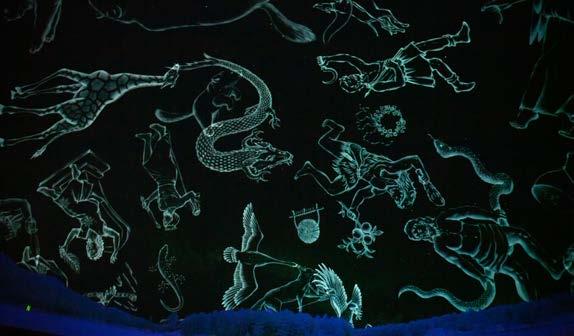
“When you look up outside, you’re subject to cloud cover or needing a big telescope,” she said. “In the planetarium you don’t need any of that and you can still get that same reaction, which is kind of fun.”
To Pahud, inspiring curiosity in people about astronomy is the fundamental goal of the Lockhart Planetarium.
“I hope to inspire people to look up when they’re outside a little more,” she said. “Thinking about our place in the universe both physically and philosophically is important, and I think astronomy is
a really good way to unlock that.”
“I also feel like sharing knowledge and sharing what we know about astronomy is a privilege,” she added.

Like Pahud, many researchers at the U of M department of physics and astronomy share a similar ideology in encouraging curiosity about space and beyond.
Samar Safi-Harb, a professor in the department of physics and astronomy, and Canada research chair in extreme astrophysics, uses her research as a means of sparking curiosity about science.
“There’s a lot of discovery in astrophysics,” she said. “When you look at the sky, you always find something new and interesting that you never even expected, so it’s a great place for discoveries, which is great for attracting students as well into the field.”
After completing her post-doctoral fellowship at
NASA, Safi-Harb came to Winnipeg to jumpstart the U of M astronomy program, which was absent at the time.
Her research examines extreme phenomena associated with the death of stars.
Stars, like the sun, eventually run out of nuclear fuel. Very large stars explode in a high-energy, dramatic explosion called a supernova. These explosions lead to the formation of heavy elements, neutron stars and black holes.
To observe these explosions, Safi-Harb uses satellites and telescopes across the electromagnetic spectrum. By studying these explosions and their byproducts, she is able to explore the physics of the extreme.
“It’s like this nearby lab in space, which allows me to understand the physics that people here on earth cannot,” she said.
Also engaged with the study of astronomy is U of M associ-
ate professor in the department of physics and astronomy Jayanne English.
English looks at the motions of galaxies — stars and their planets, dust, gas and dark matter bound together by gravity — by using their gas.
In a project with Jason Fiege, an associate professor in the department of physics and astronomy, the researchers use computational astrophysics to look at how a galaxy is rotating.
English explained that there are odd anomalies associated with this motion, which move in a different direction.
“They can be caused by two galaxies interacting together, having a gravitational pull toward each other,” she said.

“We can look at outflows of gas from galaxies, and this tells us how galaxies evolve with time, how they change, how they mature, what kind of new galaxies they’re going to turn into.”
Additionally, English is an expert in astronomy image-making and visualization. Using digital photographic data, the researcher is able to make colour maps for astronomers and images for public outreach.
“It’s a balance of both the science that is evident in the data and the art which will help engage the person, so that they spend time looking at the image and learn about this science,” she said.
English’s curiosity in astronomy began as a child. Her research in the field is an interaction between herself and the world around her.
“I think of it as becoming engaged with nature, intimate with nature,” she said.
research@themanitoban.com
Research
6 research@themanitoban.com Vol. 109, No. 26
photos / Ebunoluwa Akinbo / staff
“I hope to inspire people to look up when they’re outside a little more”
—
Danielle Pahud, U of M astronomy instructor and director of the Lockhart Planetarium
What moles and sick humans have in common
U of M biology prof studies the evolution of respiratory pigments in mammals
Robert Moshe Thompson, staff H emoglobin and myoglobin are two respiratory pigments — molecules that bind to oxygen, a respiratory gas — found in the human body.
Hemoglobin, which exists in our blood, uptakes oxygen from the lungs and delivers it across the body. Myoglobin, on the other hand, is found in the heart and muscles attached to bones and tendons, and supplies oxygen in those areas.
These two molecules are called pigments because they are responsible for the red colour of blood and muscle.
U of M professor in the department of biological sciences Kevin Campbell studies the evolution of respiratory pigments, specifically in mammals.
“One overarching theme is to understand how animals that may have oxygen insufficiency due to the environment they live in — how their hemoglobin and myoglobin
is modified to enable them to exploit these environments, for example, with low oxygen,” Campbell said.
Underground animals are typically exposed to less oxygen than those above ground. This is because the soil acts as a barrier that hinders the movement of gases into the ground. Additionally, under the earth there are relatively high levels of carbon dioxide, while oxygen levels are relatively low.
Studying animals such as moles that live in this type of environment can have medical significance for humans. The state of having high levels of carbon dioxide and low levels of oxygen is seen in respiratory conditions such as lung disease or COVID-19.
Since the lungs are responsible for the body’s oxygen intake, the failure of these organs can leave a person with less oxygen than they need to function.
“COVID is, at its heart, an oxygen deficiency disease,”
Campbell said. “People die from suffocation mostly.”
Heart disease can also result in oxygen deficiency because it disrupts the heart’s ability to pump oxygen-carrying blood.
Individuals with lung disease or COVID-19 must be supplemented with extra oxygen because human hemoglobin is not equipped to efficiently uptake oxygen when there is not enough of it in the lungs.
Campbell explained that a burrowing animal such as a mole, on the other hand, chronically deals with low oxygen levels. Because of this, its hemoglobin evolved to better pick up oxygen even when there is little available.
This is an important adaptation for smaller animals, because their oxygen requirements per gram of body mass are much higher. For example, one gram of shrew tissue requires approximately 50 to 75 times more oxygen than one gram of human tis-
sue, and about 100 times more than elephant tissue.
Part of the reason for this relatively high consumption level is that small animals lose heat quickly. One of oxygen’s major functions is heat production, so a body of that size must be able to pick up and drop off oxygen efficiently.
A result of the intensive oxygen needs of shrews is that they consume relatively more oxygen even while at rest compared to larger animals.

By contrast, human hemoglobin offloads more oxygen into the tissues when the body is in an active state, such as during intense exercise. At rest, only about 30 per cent of oxygen is offloaded.
Hemoglobin is different from most molecules in that it is specialized for two jobs rather than one. What makes it even more unique is that these two functions — picking up and releasing oxygen — are opposite tasks.
It is difficult enough for a single molecule to carry out
two opposite functions, but the hemoglobin in a small animal must be even more efficient due to their relatively resource-intensive respiratory systems.
Campbell and his team found that the same oxygen efficiency strategy evolved independently in several different animal lineages, and allows for their hemoglobin to deposit oxygen much better than human hemoglobin.
Although the animals that Campbell studies have hemoglobin, it is their mass and body proportions that really make the difference in the adaptations they have.
“Size dictates everything in biology,” Campbell said.
research@themanitoban.com
7 research@themanitoban.com March 22, 2023 Research & Technology
graphic / Dallin Chicoine / staff
Look past suburbia and experience Winnipeg

Winnipeg is good, you are just sheltered
Jory Thomas, staff
Throughout my life, I haven’t heard a lot of people rave about Winnipeg.
Recently, I drove around Winnipeg taking pictures of places that I consider to be my favourite spaces for a class project. I took photos of my own home, explored my neighbourhood and hit spots that I consider to be quintessentially Winnipeg. I let myself listen to music and appreciate these spaces and my life here.
As I got lost in Tuxedo, I got flashbacks of conversations that I had with people growing up. Like most kids do, we talked about leaving home, which to us was Winnipeg.
My friends would discuss how they felt they could never live their adult lives here, and bring up all the better places to spend our time. I listened to rants about Winnipeg’s lack of culture, and how it would be much better to live in Vancouver or Toronto. I nodded in agreement, never appreciating the city I lived in.
These kids thought that they were the connoisseurs
of Winnipeg music, culture and art, when in reality they were just privileged kids living sheltered lives in the suburbs.
Most of these people had never left their gated communities to actually experience what Winnipeg has to offer. I heard countless complaints about a lack of culture, but the only time I ever saw these people claim to have experienced culture was when they went to EPCOT during family vacation.
I heard them whine about how there was nothing to do and nowhere to go, but the most they’d explored in the city was the mall and the “forest” near their house.
who complained, but with time, my opinions have changed. I no longer think that these people are cool. Rather, I pity them for never leaving their untouched suburbs.
There is no problem with living in a suburb. The problem is complaining about our city when you haven’t even tried to experience what it has to offer. It is easy to get caught up in the hate about Winnipeg, but I’m sick of hearing about how much people hate
many displays of public art throughout the city.
Take an art class and connect with others interested in the same things as you. I know it’s not what you’re used to in beige Sage Creek, but it’ll satisfy your craving for art.
If music is more your thing, dive into the local artist scene and go to a show this weekend. I’m sure you’ll find something better than the sound of lost cars in Bridgwater.
Wherever you go, you take yourself with you
Eventually, I moved out of the suburbs and grew older. I became brave enough to explore untouched territory — places like downtown, the Exchange and the North End. Growing up, I only ever heard about the dangers these places held, never the positives that I would experience by visiting them.
I used to agree with those
Winnipeg when they haven’t even set foot outside of their little bubbles. We always hear about the cold or the fact that we are known as one of the murder capitals of Canada, but try to look past that and face Winnipeg yourself.
If you’re into art and design, there is so much to see here. You could take a stroll through the Winnipeg Art Gallery or go see the Leo Mol Sculpture Garden. Go look at the warming huts at the Forks, and the
As for culture, there is a lot to explore. We have the highest Indigenous population of any city in Canada, and there are so many thriving cultures here. In 2019, Winnipeg saw 14,580 immigrants arrive from many places across the world. You can experience these varied cultures by going to events like Folklorama, or even just befriending those with backgrounds different from your own.
At the root of all these suggestions and problems are people. Stop hanging around people that complain about living here. Sitting around
with that negativity isn’t going to make anything better. Surround yourself with people that appreciate this city — those that have made Winnipeg theirs. Once I stopped being around complainers, I started living a more appreciative life here.
Take a moment to realize whether or not you are the problem. Is Winnipeg boring? Or are you cruising around River Park South all weekend? If you move to Vancouver or Toronto, is that going to change your mindset?
Remember — wherever you go, you take yourself with you.
As you finish reading this, I hope that you’ve realized that maybe Winnipeg isn’t the problem. If you’re bored and complaining, take a step outside your comfort zone and explore your city. Before you leave Winnipeg, indulge in all it has to offer.
editor@themanitoban.com
Editorial 8 editor@themanitoban.com Vol. 109, No. 26
graphic / Dallin Chicoine / staff







Vaibhav Varma VP Finance & Operations HERE ARE YOUR 2023-2024 ELECTED UMSU EXECUTIVES VISIT UMSU.SIMPLYVOTING.COM TO VIEW FULL ELECTION RESULTS. Tracy Ayebare Karuhogo President Liam Pittman VP Advocacy Christine Yasay VP Student Life Divya Sharma VP Community Engagement UMSU EXECUTIVE OFFICE HOURS (Winter 2023) Elishia Ratel VP Community Engagement TUESDAYS @ 1PM Jaron Rykiss President MONDAYS @ 12:30PM Victoria Romero VP Advocacy WEDNESDAYS @ 12:30PM Brook Rivard VP Finance & Operations WEDNESDAYS @ 11:30AM Tracy Karuhogo VP Student Life MONDAYS @ 3:30PM Use the QR Code and send us your suggestions via Survey Monkey by March 26! $15,000? FORT GARRY CAMPUS WHAT WOULD YOU DO WITH $10,000? BANNATYNE CAMPUS WHAT WOULD YOU DO WITH UMSU’s Participatory Budget Committee needs your input! www.UMSU.ca @studentsofumsu
Embrace being cringe, reject being cool
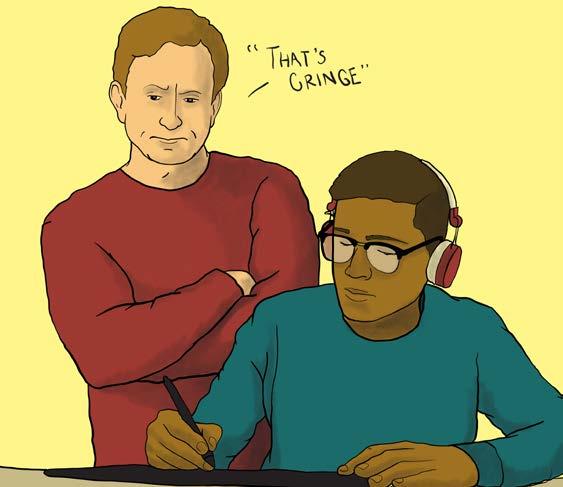
Being yourself is a lot cooler than being ‘cool’
Braden Bristow, staff
Ihave recently noticed that there are a lot of accounts on platforms such as TikTok, Twitter and Instagram dedicated to exposing “cringe,” but when I watch the videos posted on these accounts, a lot of them tend to just be people minding their own business.
Often times, the subject being called “cringe” is just a person enjoying anime, doing cosplay, looking different from other people or engaging in some other random behaviour that really does not harm anyone.
Reuploading someone’s video with a caption making fun of them for your thousands of followers is just bullying. Naturally, because the internet allows anonymity and enables mass communication, it makes bullying really easy. But that does not mean it is okay to pick on someone because their appearance or interests are different than yours.
Dressing up as an anime character and dancing in front of a camera is a bit odd. But realistically, there is no harm in doing so. If it brings someone a smile or makes them feel happy, then we should either leave them alone or be supportive of their interests.
Which brings me to my point — as a society, we should be more willing to engage in “cringe” behaviour. Refusing to engage in behaviour that would be labelled “cringe” is cowardly. We should not refuse to do something that will make us happy just because someone else might judge us for it.
For example, when I was growing up, I had a lot of special interests. I would get fixated on a topic, TV show, movie or video game and obsess over it for a while. In fact, I still do this. But when I was younger, I found out that talking to people about cartoons, niche historical topics
and video games was really uncool.
This ultimately led to me bury my interests while in public, and to make friends that did not really understand what I was interested in. I knew that talking about what I watched, played or read about over the weekend would ostracize me.
“weird” stuff we like, I think we would all be happier. That cartoon you enjoy is not as silly as you think it is, and that game you have one hun-
Bury it as much as you want, you are still you
dred hours in is actually kind of cool.
But I should not have censored my hobbies or interests for people who do not value me for who I actually am, and neither should you. If we all talked more freely about the
I think many of us want to be accepted, so we dilute ourselves for others. Diluting yourself to please others only harms yourself. Bury it as much as you want, you are still you.
You could read into that
statement and see it as a commentary on sexuality, gender identity or some other facet of identity, and it would still hold true. Hiding a part of yourself is unnecessary. There will always be people who try to tear you down for who you are, what you like and who you like. But the more people that live their honest truth, no matter how different, the better we all are for it.
Being yourself can be difficult because it means you are being vulnerable. When we mask ourselves, we cannot be
hurt by someone’s teasing or their exclusion, but when we are our honest selves, we carry that risk.
Being vulnerable is worth the risk because it means we can honestly enjoy our truth, identities and interests. You might get put on some stupid Instagram account with thousands of followers, but you looked good doing it and you had fun. That has to be worth something.
comment@themanitoban.com

Comment 10 comment@themanitoban.com Vol. 109, No. 26
graphic / Dallin Chicoine / staff


Putting people above politics
Students in government are more than just their positions
Rohan Sethi, volunteer T
he misinformation and disinformation that spreads as often as it does within the sphere of student governance draws from the juxtaposition of two age-old sayings — “no news is good news,” but “good news doesn’t sell newspapers.”
Let’s face it, controversies make for great conversation starters and sensational headlines.
To see this in practice, look no further than the recent University of Manitoba Students’ Union annual general election.
A flood of complaints, an unprecedented situation for the presidential vote and the dissemination of half-truths and mistruths about grievances that were in the public domain well before ad hominem attacks were launched against the Chief Returning Officer all serve as reminders of a troubling trend — the growing lack of distinction between political positions of power and the individuals serving in them.
This does not mean that people are not entitled to their own opinions. After all, one of the foundational principles of a democratic institution is the guarantee that different views and perspectives are welcome for discussion, debate and deliberation in a reasonable and responsible manner.
Yet, restraint has been pushed to the side and replaced with an echo chamber where harsh, demeaning criticisms are levied against high-level figures serving in student government, in public spaces and behind closed doors.
Leaders are being confined to their positions as justification for these rebukes, with little to no regard for their personal lives outside of politics. The unspoken expectation is to tolerate the onslaught of attacks because it’s part and parcel of the job.
Warranted or not, it is important to ask whether the comments and critiques one makes are directed at a student leader’s policies or the individual in that position.
As an elected student serving as president of a faculty association, I am familiar with the rigours and stresses that come with student governance. From personal experiences and through conversations with other students in leadership positions at various levels, I have noticed that the issue of ad hominem criticism is becoming widespread.

I am well aware that criticism is built into the fabric of leadership positions and governance structures as a whole, be it the UMSU board of directors or the House of Commons.
You’re damned if you do, and damned if you don’t.
Disagreements over policies, however, should not be a free pass for people to make hurtful comments or write the first thing that comes to mind, because words matter. Behind each position is a living, breathing person susceptible to imperfection and deserving of respect.
Student leadership is demanding in its own right, and the responsibilities of
such roles exact an emotional, mental and physical toll. For all the public appearances and name recognition associated with holding elected office, feelings of isolation and emotional distress are commonplace.
Decorum demands that we keep our heads held high, exercise restraint and a lack of emotion in the face of hurtful and ignorant comments and remain focused on our mandates with the unspoken expectation that under-appreciation comes with the job.
The normalization of these attitudes presents the pros-
Using the loopholes in our DNA
Privacy should be upheld when we submit our DNA

Sarah Cohen, staff
My mom said that every parent’s worst fear is what happened to three-year-old Madeleine McCann in 2007 when she disappeared from her family’s accommodations while vacationing in Portugal.
Fast forward to this past February, when a Polish woman named Julia took to the internet claiming she had evidence that she was the missing child. With much anticipation from the true crime fanatics of the world, Julia has said that she wants to submit her DNA for testing in the hopes of coming up with a concrete answer as to whether or not she is the missing child.
It is possible that she may use a genealogy site to try to trace her family lineage, similar to 23andMe. This got me thinking about Joseph James DeAngelo Jr., better known as the Golden State Killer, who was identified and arrested nearly 50 years after his murder spree began thanks to DNA submitted to sites that trace ancestry.
The Los Angeles Times reported that investigators used DNA from a rape kit collected from a victim of the
Golden State Killer to create a fake profile on a family tree tracing site, through which they found his family members and then identified him.
I am all for finding the infamous criminal, but this feels particularly sneaky to me.
The question now is whether voluntarily submitting our genetic codes to databases that may give that information to law enforcement is edging in on the realm of personal privacy. If I submit my DNA in the hopes of finding out where in Europe my Jewish ancestors emigrated from, will that be used to one day identify my
long-lost relative who committed heinous crimes by police who create a fake profile?
Ancestry, another company that uses DNA to trace family trees, claims that they will only give data to government officials should they be compelled to by the proper legal documentation. The same goes for 23andMe. To me, it seems like the detectives in the Golden State Killer case found a loophole.
In trying to solve other cases
that once ran cold, U.S. investigators have been known to run DNA for matches against one of the many databases like Ancestry. This could be seen as a helpful tactic or, alternatively, an abuse of power.
I think that law enforcement using lineage tracing companies to solve cases is an abuse of power. When a person agrees to the terms of service, they should be assured that their privacy will be protected and only sought out by actual relatives, not by the police trying to find someone.
Alternatively, if national and international agencies like CSIS, the FBI or INTERPOL want a database of DNA given voluntarily, then they should cre-
pect of more unprecedented election campaigns, higher rates of burnout, stagnated or declining interest in running for a position in student governance and poor mental wellness.
To counteract these concerns, it’s time to establish some boundaries between criticism of a person’s political activities and personalizing said criticism.
comment@themanitoban.com
ate that. I bet plenty of people would willingly give a sample of DNA with the hope that it would solve a case here in Canada or internationally.
The thing is, there are cases that the true-crime fanatic in me wants solved, and one way of solving them is through DNA. Take JonBenét Ramsey. JonBenét was six when she was murdered in her home. The 1996 murder case went cold, but renewed efforts delving into the magical world of genetic codes could solve her case once and for all.
This is where I am torn. I want to be assured of my privacy and of a secure exploration of family history should I decide to do so, but I also want criminals to be identified and rightly dealt with. Ultimately, I think that law enforcement parties should only be conducting investigations in a way that follows honest processes. comment@themanitoban.com
12 comment@themanitoban.com Vol. 109, No. 26 Comment
graphic / Jenna Solomon / staff
graphic
/ Jenna Solomon / staff
Support for Palestine is crucial
Worldwide support is necessary to stop the occupation of Palestinian territories
Dina Hamid, staff
Ongoing conflicts in occupied Palestine beg the question of whether it is a fair two-sided conflict when Palestine and the Palestinian people have always gotten the short end of the stick.
Early foreshadowing of the present-day political conflict can be found in the rise of modern political Zionism in the late 1800s, which was primarily fuelled by wide-spread antisemitism in Europe.
This led to an increase of Jewish immigration to Ottoman Palestine, which Arabs in the region saw as a European attempt at colonization, and violence began between the two groups. When increased immigration to British-controlled Palestine began, the land had a Muslim Arab majority population.
The fighting intensified so much that the British asked the newly formed United Nations (UN) to find a solution. In 1947, the UN proposed to divide the territory into two distinct states, one Jewish and one Palestinian Arab. Fighting continued, though, and neighbouring Arab countries went to war with the newly formed Israel. The Palestinian and Arab forces lost to Israeli forces, and the war caused the Nakba in 1948 — Arabic for “catastrophe” — where as many as 750,000 Palestinians were displaced.
The UN Relief and Works Agency for Palestine Refugees in the Near East estimates that today there are about 5.9 million Palestinians descended from refugees of the 1948 conflict who also qualify for refugee status.

According to the UN, Israel held more than 77 per cent of what was formerly British-controlled Palestine by the end of the 1948 war. The UN proposal in 1947 would have granted them 56 per cent of the territory.
After the 1948 conflict, the Gaza Strip was controlled by Egypt, while the West Bank and East Jerusalem were controlled by Jordan. In 1967, another war took place that lasted six days, which ended with Israel in control of the West Bank and Gaza Strip, two regions home to large populations of Palestinians, as well as East Jerusalem.
In 2022, a UN commission of inquiry issued a report that found Israel’s continued occupation of Palestinian territory to be illegal under international law. The commission considers occupied Palestin-
ian territory to include East Jerusalem, the Syrian Golan, Gaza and the West Bank outside of East Jerusalem.
Additionally, groups like Amnesty International and Human Rights Watch have found that Palestinian residents of these areas have suffered many consequences as a result of occupation, including discrimination, restricted mobility and restricted access to water and other natural resources. The UN considers over 96 per cent of war-torn Gaza’s water to be contaminated and undrinkable.
The occupation has been further exacerbated by Israel’s facilitation of what the UN and much of the international community deem to be illegal settlements in the West Bank, as well as the forced eviction of Palestinians and demolition of Palestinian homes to construct Israeli infra-
structure. This process has left many Palestinian families and communities displaced and destitute.
Just last year, the high courts of Israel approved the eviction of 1,000 Palestinians from a region of the West Bank, home to at least eight small Palestinian villages, to claim land for military use. These kinds of actions further act as barricades that prevent Palestinians from ever having an independent state.
As a result of the ongoing violence, several Palestinian political and military organizations were started, most notably Fatah, predominant in the West Bank, and Hamas, a radical nationalist and militant organization that oversees the Gaza Strip. However, there is no cohesive Palestinian front that can unify against the Israeli occupation because the two groups have fundamentally opposing political ideologies.
Despite all these glaring violations against inter-
national law and human rights, the Israeli government barely faces any pushback from other states for its unjust attempts at colonization, especially when compared to Russia today.
In fact, the U.S. gave the Israeli government US$3.8 billion in aid in 2020 and sold US$735 million dollars’ worth of weapons to the nation — which go toward further assisting the displacement of Palestinian people and the settler colonialism of Palestinian territory.
The international community has done a great disservice to the Palestinians by allowing the criminal actions of Israel to go unchallenged for this long. Western countries like the U.S. and Canada’s friendly ties with Israel silently enable their settler colonialist efforts.
in thousands of innocent Palestinian civilian casualties — contributes to the ethnic cleansing of the Palestinians from their homeland.
It is crucial to emphasize that the Israel-Palestine conflict is a land issue. The Jewish community should not have to answer for the actions of the Israeli authorities. The Israeli government and those directly responsible for the uprooting of Palestinians should be the only ones held accountable.
I know what the just solution for this occupation could be, but I don’t know what a realistic solution would mean. I do know that I believe that Palestinians deserve the right to have a home on their land, and there is no way to accomplish that without the support of the world.
The Israeli occupation of Palestinian territories has deprived Palestinians of the opportunity to have their own sovereign state and has left them vulnerable and without a home. Not criticizing Israel’s corrupt land-grab strategies and ongoing use of excessive force — which has resulted comment@themanitoban.com
13 comment@themanitoban.com March 22, 2023 Comment
graphic / Dallin Chicoine / staff
I believe that Palestinians deserve the right to have a home on their land
From our archives 100 years ago
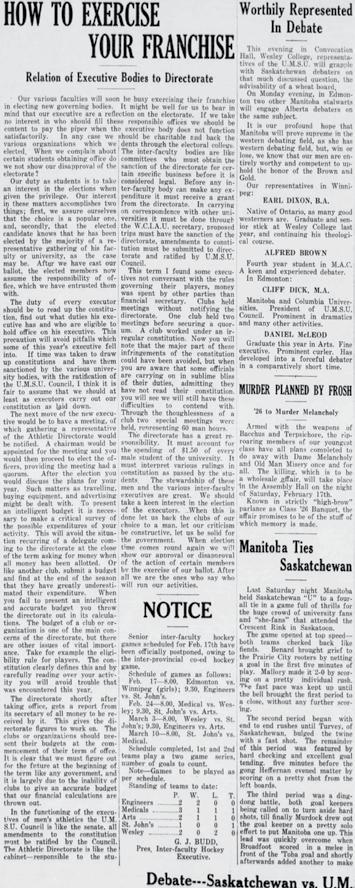


phdcomics.com


RESEARCHERS CLAIM TO HAVE SYNTHESIZED SIX ADDITIONAL ELEMENTS IN THE SECOND ROW, TEMPORARILY NAMED “PENTIUM” THROUGH “UNNILIUM”.
To complete Sudoku, fill the board by entering numbers 1 to 9 such that each row, column and 3x3 box contains every number uniquely
In Hidato, fill the board by continuing the chain of numbers from 1 to 100 moving any direction or diagonally to the next number.


rows and columns are divided by black . These need to be filled in with numbers that is a set of numbers with no gaps but can be in any order, eg [4,2,3,5]. Clues in black cells remove that number as an option in that row and column, and are not part of any straight. Glance at the solution to


To complete Sudoku, fill the board by entering numbers 1 to 9 such that each row, column and 3x3 box contains every number uniquely.
For many strategies, hints and tips, visit www.sudokuwiki.org
If you like Str8ts check out our books, iPhone/iPad Apps and much more on our store. The solutions will be published here in the next issue.
In Straits, like Sudoku, no single number can repeat in any row or column. But rows and columns are divided by black squares into compartments. These need to be filled in with numbers that complete a “straight.” A straight is a set of numbers with no gaps but can be in any order, eg [4,2,3,5]. Clues in black cells remove that number as an option in that row and column and are not part of any straight. Glance at the solution to see how “straights” are formed.
To complete Sudoku, fill the board by entering numbers 1 to 9 such that each row, column and 3x3 box contains every number uniquely.
For many strategies, hints and tips, visit www.sudokuwiki.org
If you like Str8ts check out our books, iPhone/iPad Apps and much more on our store. The solutions will be published here in the next issue. can find more help, tips and hints at
How to beat Str8ts –Like Sudoku, no single number can repeat in any row or column. But... rows and columns are divided by black squares into compartments. These need to be filled in with numbers that complete a ‘straight’. A straight is a set of numbers with no gaps but can be in any order, eg [4,2,3,5]. Clues in black cells remove that number as an option in that row and column, and are not part of any straight. Glance at the solution to see how ‘straights’ are formed.
and
Diversions 14 graphics@themanitoban.com Vol. 109, No. 26 7538 87165 67 763 125 24 67485 5739 © 2023 Syndicated Puzzles 214859376 359764281 678132459 835421697 926578143 147693528 461287935 583946712 792315864
SUDOKU
No. 633 Medium Previous solution - Easy Answer to last issue’s Hidato xkcd.com
8 71 4 82 3 8 3 12 29 9 6 5 1 2 4 © 2023 Syndicated Puzzles 753 6748 5 STR8TS No. 633 Medium 452389 6512378 785436 5761243 839745612 9768543 689721 1289754 216879 6 49
5
1 3
Previous solution - Tough SUDOKU The solutions You can find more help, tips and hints at www.str8ts.com No. 633 8 12 7538 87165 67 763 125 24 67485 5739 © 2023 Syndicated Puzzles 214859376 359764281 678132459 835421697 926578143 147693528 461287935 583946712 792315864 STR8TS 633 SUDOKU
No. 633 Medium
8 71 3 8 3 9 5 1 2 Puzzles STR8TS No. 633 Medium 452389 6512378 785436 5761243 839745612 9768543 689721 1289754 216879 6 49 1 3 5
to beat Str8ts –
can repeat in any row or column. But...
columns are divided by
squares into compartments
These need to be filled in with numbers that complete a ‘straight’. A straight is a set Previous solution - Tough Answer to last issue’s Straights
Previous solution - Easy Answer to last issue’s Sudoku
How
Like Sudoku, no single number
rows
black
.
Sudoku
Puzzle by Syndicated Puzzles
Hidato
Puzzle by M.J.D. Doering
Straights
Puzzle by Syndicated Puzzles
Horoscopes for the week of March 22
Zodiac tips for surviving life at the U of M
Damien Davis, staff
ARIES
Your symbol for the week is a Log. Have you ever found yourself staring too hard at the flames in the fireplace? March will have you asking where your passion went, so think with your heart rather than your mind. Your skeleton is made of forest fires, and the embers of your heart will speed up the process of melting the frozen ground surrounding you.
TAURUS
Your symbol for the week is a Wand. Who are you when you are not performing for others? At the bottom of the magician’s hat, you wonder what a life without deception could be like. Find out for yourself. What good does it do to sit around and think of all the “what-ifs?” You could do more than survive, you could thrive.
GEMINI












Your symbol for the week is a Beetle. The fear that is burrowing inside you and your inner self is preventing you from breathing in the air of spring. Even if it doesn’t always feel like it, you are in control, not your anxieties. Twins symbolize duality. Show your peers what it means to be both kind and cruel when necessary.
CANCER
Your symbol for the week is an Abandoned Building. Things have not gone the way you wanted them to. You’ve found yourself falling into line time and time again. Stop resisting. This is not a time of senseless chaos but a catalyst for personal transformation. You are more than what you believe yourself to be.
LEO
Your symbol for the week is a Crossroads. This week you should practise making a decision and sticking to it. You are not in a place to be acting impulsively, so gather your things and consult your mentors. There is truly nothing more satisfying than knowing you made the right choice. Are you holding the reins of your destiny, or is someone else?
VIRGO
Your symbol for the week is a Clown. Caution is your friend again. Meticulous planning with the hope of a relaxed week is your best chance at prep aration during the end of this term. There is a comfort in being the comedic relief, but how long before you start believing the jokes about your own undoing?
LIBRA
Your symbol for the week is a Bedsheet. Loneliness can come even when surrounded by those who love you. You have not been abandoned, and while you’re no stranger to giving and not receiving, take comfort in the company of yourself. If you become your own home, friend and sanctuary, you will find that you will never be truly lonely. Treat yourself tenderly this week. You come first.
SCORPIO
Your symbol for the week is an Ashtray. What do you gain from putting out the flames of your passion? You may think you’re operating on the idea that if you maintain a persona of serenity, others will prefer your presence, but censoring yourself has never done you good in the past. Celebrate who you are, in all your bad and all your good.
SAGITTARIUS
Your symbol for the week is a Wheel. Sometimes, running feels like the only option left. When the winds of change catch up with us, they do not always come in the form of a spring breeze, instead sometimes manifesting as a violent tornado. Know that we are made up of choices, and that if you are willing to stay and fight for a future with laughter and kindness, you will always have someone ready to stand with you. Turn the wheel and head to the place you call home.
’Toban Tips
How to end a ‘situationship’
Toby the Bison, staff

Dear Toby,
I have been in a month long “situationship.” We have been hanging out, gone on a few dates and done a little kissing but there is no commitment and nothing official. I think she wants to change that, but I want to end things. She is really nice but just not my type. How should I end the situationship without hurting her?
Help, Situationally stuck
Dear Situationally stuck,
Situationships are tough because they encompass every part of a relationship without being official. In these types of relationships, it is really hard to discern how to end things. One person may have feelings and want to continue, while the other may not. This is where communication comes into play. Being completely transparent with your feelings is of the utmost importance in situationships. Let her know how you feel before she plans a future
with you. And no matter what, do not lead her on.
Hopefully, she will be understanding and appreciative of the transparency. Also, remember that once you end it, it’s over. Don’t be wishywashy or try to go back on your decision.
Wishing you the best of luck, Toby the Bison
To ask Toby a question, email comment@themanitoban.com
CAPRICORN
Your symbol for the week is a Crystal. You’ve been digging into things you thought you were ready to face this week, but they have proven to be harder to grasp than you originally thought. There’s no shame in heading back up from the earth’s core and replenishing before starting again. The journey of self-healing has no time limit, so pace yourself this week.
AQUARIUS
Your symbol for the week is an Orange. You are peeling off all that limited you from last week as you make your way into spring. These chains you put on yourself in your attempts to be free do not serve you anymore, and so it is time to get rid of them. You’re known for your independence, but it’s never wrong to receive help, especially when you’re struggling. Rest easy, all will be well in the end.
PISCES
Your symbol for the week is Lightning. Self-sacrifice can be tempting and even easy, but does martyrdom suit you? Do what you always do — move swiftly through the odds and come out stronger. Don’t confuse perfectionism with careful planning, and most importantly, remember that you can easily become your own worst enemy.
15 graphics@themanitoban.com March 22, 2023 Diversions
UMAnime hosts manga club
U of M student group facilitates forging friendships

Jessie Krahn, staff
UMAnime recently introduced its manga club, a regular event for students to read portions of manga series and discuss them with fellow fans.
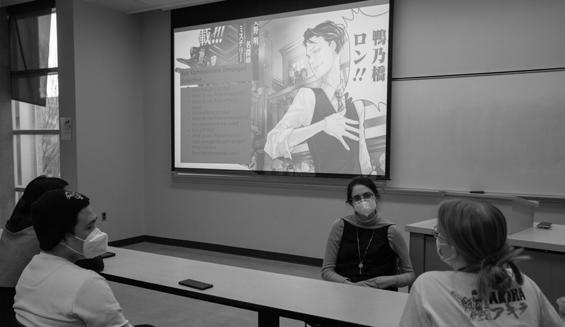
Manga are Japanese graphic narratives. Just like other comics around the world, manga comprises a wide variety of distinct genres from romantic slice-of-life comedies or explosive action series to psychological horror.
One of UMAnime’s event planners, Kaitlyn Goncalves, is a master’s student in the U of M’s department of English, theatre, film & media. She created the manga club as part of UMAnime’s regular programming.
According to Goncalves, offering an array of frequent events in order to provide students with the opportunity to convene, chat and forge new relationships on the foundation of their shared interests is a priority for UMAnime.


Most of the group’s programming was moved to virtual formats to abide by public health orders during lockdowns.
Prior, when UMAnime was smaller and could invite members to gather in its club room, the club served as a space for students to swap volumes of manga and talk about mutual favourites.
During one of UMAnime’s recent coffee hours, Goncalves noticed people discussing manga. From there, Goncalves realized that a manga club structured like a book club would give students a place to gather, read specific titles and engage in discussion about manga specifically.
The response to Goncalves’s initiative was striking, with the last manga club meeting drawing about 30 attendees.
Goncalves explained that one of her goals for the manga club was to provide structure to the discussion beyond a conversational format. She creates discussion prompts to give the group a starting point.
Goncalves said that her background in English has helped her approach organizing the club.
“As an English major you’re focused on the critical thinking of different themes and the [depth] of characters or the genre,” she said.
“In the last meeting I was surprised,” she continued. “I understand everyone is a student, and not knowing what
their background is currently but it’s nice to see students really getting into talking about the manga and bringing up different stuff that I haven’t thought about.”
Overall, Goncalves said that gathering in person has added benefits because there is time after meetings for students to mingle and create one-on-one relationships. She believes that the “in between-ness” of the time after meetings gives people space to make friends.
“It’s the after,” she explained. “Because then after people can talk amongst themselves, actually build friendships and leave the manga club being like, ‘hey, what are you doing after this?’ Because with online, you’re there for one purpose and
Saturday,
Sunday,
then you just click away.”
While students are juggling “reading textbooks and things they have to read,” Goncalves thinks “it’s nice to have a reason to read something fun like manga.”
Anime and manga are often categorized by the demographics they are marketed toward. Shounen manga, for instance, refers to manga aimed at boys, while shoujo manga refers to manga aimed at girls.

For Goncalves, exposing readers to an assortment of manga — from shoujo to shounen — is important.
“What I’ve noticed is when it comes to anime, I guess both anime and manga, there’s definitely a favouritism in genres, shounen definitely being one
of them,” she said.
“Even though it’s just the U of M crowd, my plan is to show and broaden the spectrums of genre in manga so that we’re not stuck into this popularity contest.”

Ultimately, Goncalves hopes the manga club will draw enough interest for someone to be able to take over the club and continue it in future.
Students interested in learning about UMAnime’s programming can visit https://umanime.club/ for more details.
Saturday, April 15, 8:00 pm


Sunday, April 16, 2:00 pm

Arts & Culture 16 arts@themanitoban.com Vol. 109, No. 26
SPONSORED BY IN ASSOCIATION WITH
photo / Ebunoluwa Akinbo / staff
Brandon Goldberg Trio
Joe Locke Quartet with Kenny Washington
March 25, 8:00 pm
Tickets: www.izzyasperjazz.com Berney Theatre - Rady JCC - 123 Doncaster Street Student Tickets $20 with Student ID Regular Tickets $45
March 26, 2:00 pm
arts@themanitoban.com
’Toban turntable
Nicholas Krgovich — Ducks

Alex Braun staff
4/5 Stars
“For years and years, I guess I was lonely” is the first line on Ducks, and it’s the first of many profound shifts in perspective that are framed as perfectly mundane — the rest of the verse is about chatting with a friend over a beer on your front stoop.
Nicholas Krgovich has quietly become a mainstay in the indie world, collaborating with legends like Dear Nora and Mount Eerie and shacking up with Orindal Records, run by Owen Ashworth of Advance Base.
If any of those names ring a bell, you might know the vein that Krgovich mines in his music.
If they don’t, then think about the name of the record Ducks.
Think about a nice afternoon watching the ducks in the pond on a sunny spring day, contemplating life and soaking in the details of the world around you — the glim-
mer of the sun in little puddles, the movement of leaves in the wind and the way the clouds above you break apart and drift back into each other.
Krgovich’s lyrical obsessions are so banal and small that they loop back to being massively meaningful in some Zen-like way. These songs are littered with references to the weather, the beverage he’s drinking, chores, snacks — all these little details of time spent in quiet reflection, alone.
Musically, the album is deceptively low stakes. Recorded alone by Krgovich on a 4-track tape machine, the record has a fuzzy, intimate warmth and summery breeziness, taking cues from Yo La Tengo, Broadcast and the innocence of Beat Happening.
But Ducks never delves into cutesiness or sentimentality. Its perspective is one of newfound self-awareness — the placid calm of middle age and perspective of a life largely lived.
Occasionally, it borders on
navel-gazing, but the brevity of the songs and the album as a whole keep Krgovich’s simple musings from grating too much.
By the end of a record the scope expands a bit too, like on the celestial-minded “Scorpio Rising (Grace Chen),” or the last track, “Eating Last Year’s Apples in July,” a frank reflection on relationships past and a final resolve to let love in.
Ducks is an excellent album for spring. It has the feeling of waking up out of winter hibernation to find new, exciting details in the everyday.
It reminds me of spring 2020, a time that left us with nothing but room for boredom and contemplation. And we could all use a bit more meditative calm in our lives.
Ducks is available on major streaming services.
arts@themanitoban.com
Celebrating our ancestors who are Close to Home
Ukraine: Close to Home opens at Canadian Mennonite University gallery

Damien Davis, staff Canadian Mennonite University’s MHC gallery hosted the opening of two new exhibits on March 10 that deep dive into the idea of home.
Writer and artist Margaret Shaw-MacKinnon is the creator of the exhibit Ukraine: Close to Home. The show is dedicated to her Ukrainian immigrant grandparents, who came to Canada as part of the first wave of immigration beginning in the 1890s.
For Shaw-MacKinnon, the journey to find information on relatives whose history seemed lost in her family tree began sporadically about 12 years ago. Her research intensified following Russia’s invasion of Ukraine.
“With the war in Ukraine I just felt like, ‘I have got to delve into this in a deep way,’” Shaw-MacKinnon explained.
“It’s been an amazing year of immersing into the lives of first-wave Ukrainian immigrants, and into retrieving my family heritage that was lost through ethnic discrimination and life trajectories.”
Shaw-MacKinnon described how, at the start of her research process, she was reading information about Ukraine, begin-
ning with its history. During all this research, she came across a piece of writing about her great-grandfather written by one of his friends. It was through this text that she learned the two of them had built a church together, and that for nine years her great-grandfather had preached there. After devoting time to her research, Shaw-MacKinnon
began painting while attempting to incorporate what she had learned into her pieces.
“That was a very interesting process because I wanted to capture the history and yet make the paintings accessible and folkloric and narrative,” she said. “So, I wove in little symbols that have meaning and painted with colours that also have meaning.”
For Shaw-MacKinnon, this
images / Margaret Shaw-MacKinnon / provided journey has been a chance to learn about and connect with this side of her ancestry she had not previously been well aware of.
“While I learned so much about my Scottish ancestry, I really didn’t learn much at all about the Ukrainian heritage, except that my father took me to the North End when I was a little girl to paint Ukrainian Easter eggs, or to use the wax, the dyes,” she said.
“He must have been standing by with such a feeling, seeing me engaged in that.”
Shaw-MacKinnon said that she would like attendees to think about their own family stories and what their family has been through.
“When so much of the world is enduring war, what are we doing with our peace?” she said. “How are we measuring up to what our ancestors sacrificed for us?”
Answering these questions can seem daunting, but all it takes to start is a little bit of interest.
“Be curious about where you come from and where you’re going,” she said.
Ukraine: Close to Home is open to the public and located at MHC Gallery from March 10 to April 29
arts@themanitoban.com
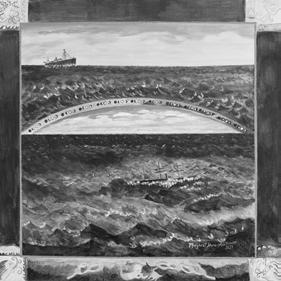
17 arts@themanitoban.com March 22, 2023 Arts & Culture
image / Orindal Records / provided
Its perspective is one of newfound self-awareness
Bisons swim in Speedo Western Canadian championship

The herd
Quinn
rallied together for the annual competition
Mayhew, staff
The University of Manitoba’s swim team competed in the annual Speedo Western Canadian championship in Calgary, Alta. this past Thursday, March 16 to Sunday, March 19.
Typically, the team doesn’t participate in the Speedo Western Canadian championship, opting instead to swim at its home meet, the ManSask championships. Therefore, it was a surprise to see them at this competition but a welcome one, nonetheless.
ber of 15 points from her fantastic swim.
Ripping it up in the pool this weekend was none other than the team’s butterflyer, Andriy Usan, who absolutely crushed the 50-metre fly with a blisteringly fast final time of 25.24, helping him place fourth and qualify for the U-Sports swimming championship next season.
only medal of the meet for the herd, obtaining a preliminary time of 1:06.99 in the women’s 100-metre backstroke event, and a final time of 1:05.81 to place third, and take off an astronomical 1.18 seconds between her prelims and final time.
Senior swimmers Dora Modrccin and Mozill will be graduating this year, as the end of both the swim season and school year slowly creep up.
Graduating swimmer Megan Mozill achieved the only medal of the meet for the herd
The team rallied together as it sought to achieve new best times, podium finishes and consistently make finals.
Kelsey Fillion started the weekend off for the herd, swimming the 200-metre freestyle in 2:08.38, good enough for fourth place, while she also split her middle 100 of the 200-metre freestyle to ultimately clinch a total num-
To add to the wealth of top tier Bison swimming, fourth year swimmer Georgia Pengilly dominated the 50-metre backstroke with a preliminary time of 30.61. In the finals, she shaved off 0.21 seconds for a time of 30.40. Pengilly placed fourth with a total number of 15 points, all of which were earned in the 50-metre backstroke.
Graduating swimmer Megan Mozill achieved the
It’s safe to say both of these women contributed immensely to the team — especially when it came to podium finishes — but also by just keeping the team’s energy high. These women were at the heart of the swim team’s culture and they will be missed greatly by the remaining members of the swim team and also by Bison athletics.
The Bisons have been dynamite in both competition and training all year long. And
with more and more of the U of M swim team qualifying for U-Sports, we can raise our expectations for the herd to start ranking even higher than it did this season in both the Canada West conference and U-Sports rankings next year.
The swim team’s not quite done yet this year. The herd’s
sports@themanitoban.com

Sports 18 sports@themanitoban.com Vol. 109, No. 26
season closer at the Canadian Swimming Trials takes place from March 28 to April 2 in Toronto, Ont.
photo / Faith Peters
/ staff
Education with a destination
Your ticket to a career with endless variety.
The program accelerated my career by at least ve years. I love the variety, I love the diversity and I love the people.”
AN INITIATIVE BY:
Accelerate your career when you join a tourism education program. Browse available programs at travelmanitoba.com/tourism-education
 SYLVIE FOIDART | TOURISM COORDINATOR ECONOMIC DEVELOPMENT COUNCIL FOR MANITOBA BILINGUAL MUNICIPALITIES (CDEM) GRADUATE OF TOURISM MANAGEMENT ST. BONIFACE UNIVERSITY
SYLVIE FOIDART | TOURISM COORDINATOR ECONOMIC DEVELOPMENT COUNCIL FOR MANITOBA BILINGUAL MUNICIPALITIES (CDEM) GRADUATE OF TOURISM MANAGEMENT ST. BONIFACE UNIVERSITY
Bison football alumnus making inroads in the NFL
David Onyemata inks US$35 million deal with NFL’s Atlanta Falcons
Joshua Brandt, staff
T his past Thursday, March 16, former Bisons football star and University of Manitoba alumnus David Onyemata signed a three-year US$35 million contract with the National Football League’s (NFL) Atlanta Falcons.
The contract guarantees the 30-year-old former environmental science major at least US$24.5 million.
Famously, Onyemata became the first University of Manitoba football player to be drafted into the NFL in 2016 when he was selected 120th overall by the New Orleans Saints. Born in Lagos, Nigeria, Onyemata’s journey to NFL glory was anything but expected. Instead of playing gridiron football at an early age, he grew up playing another kind of football, what us North Americans call soccer.
Onyemata had never played North American football until he arrived on campus at the U of M in 2012.
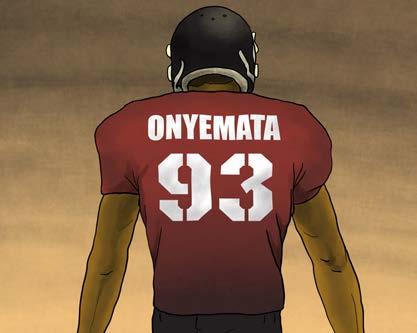
The first time Onyemata stepped foot on the gridiron, the Bisons’ coaching staff
were greatly surprised at the nimbleness and fluidity of movement the six-foot-four, 300-pound stud displayed. The coaching staff put him on the defensive line, and the rest is history.
During his tenure with the herd — from 2013 to 2015 — Onyemata racked up 166 tackles, nine and a half quarterback sacks, one forced fumble and one fumble recovery in 37 career games.
He was also named to two Canada West conference allstar teams and one Canadian Interuniversity Sport all-Canadian team.
Most prestigious of all was Onyemata’s 2015 win of the J. P. Metras trophy, awarded to the best lineman in Canadian collegiate football.
Onyemata began his NFL Career in 2016 with the New Orleans Saints, appearing in all 16 regular season games. He would go on to play for the Saints for six more years before signing with the Saints’ National Football Conference South division rival Atlanta Falcons as a free agent this off-season.
Onyemata’s most prolific NFL season was the 2020-21 campaign, in which the former U of M defensive stalwart accumulated 44 total tackles, six and a half sacks and one interception in 15 regular season games. He also added five tackles in two post-season games that year, as his Saints bowed out in the Divisional
Round, losing to the eventual 2021 Super Bowl champion Tampa Bay Buccaneers.
Onyemata’s decision to sign with the Atlanta Falcons seems largely predicated on his desire to reunite with former New Orleans Saints defensive line coach Ryan Nielsen, who was recently hired by the Falcons this January.
Sports teams’ schedules
Winnipeg Jets
Though Onyemata possessed a slew of natural talent, his incredible journey to the NFL and his solid production is nothing but a testament to the quality of the Bisons’ football program, for it developed him.
sports@themanitoban.com

U-Sports championship playoffs
Quarterfinals:
Bisons @ Mount Royal Cougars
Semifinals:
Bisons @ UBC Thunderbirds
Bronze medal:
Bisons @ Dalhousie Tigers
U of M Bisons — Swimming
Canadian Swimming Trials
March 17 — 3 – 2
March 18 — 1 – 3
March 18 — 2 – 3
March 28 – April 2
Jets @ Carolina Hurricanes
Boston Bruins @ Jets
Jets @ Nashville Predators
Jets @ St. Louis Blues
Arizona Coyotes @ Jets
Jets @ Anaheim Ducks
Jets @ Los Angeles Kings
Jets @ San Jose Sharks
* All times CDT
March 14 — Final: 3 – 5
March 16 — Final: 3 – 0
March 18 — Final: 3 – 2 / OT
March 19 — Final: 0 – 3
March 21 — 7 p.m.
March 23 — 9 p.m.
March 25 — 3 p.m.
March 28 — 9:30 p.m.
20 sports@themanitoban.com Vol. 109, No. 26 Sports
Onyemata had never played North American football until he arrived on campus at the U of M
of M Bisons — Women’s Volleyball
U
graphic / Dallin Chicoine / staff






























































 SYLVIE FOIDART | TOURISM COORDINATOR ECONOMIC DEVELOPMENT COUNCIL FOR MANITOBA BILINGUAL MUNICIPALITIES (CDEM) GRADUATE OF TOURISM MANAGEMENT ST. BONIFACE UNIVERSITY
SYLVIE FOIDART | TOURISM COORDINATOR ECONOMIC DEVELOPMENT COUNCIL FOR MANITOBA BILINGUAL MUNICIPALITIES (CDEM) GRADUATE OF TOURISM MANAGEMENT ST. BONIFACE UNIVERSITY

